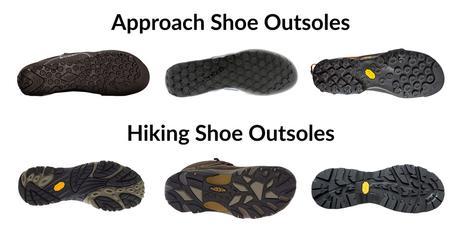Go to any outdoor retail store and explore the footwear section. You’re likely to find a section dedicated to approach shoes. What are approach shoes exactly, you might ponder. Are they for bachelors looking to talk to beautiful women? Well, no. Though they might look like hiking shoes at first glance, on closer inspection, you’ll soon learn that their purpose is a little more specialized. Let’s explore them further.
What Are Approach Shoes?
Approach shoes lie in-between that weird region of climbing shoes and hiking shoes. When comparing them to hiking shoes, the first thing you’ll probably notice about them is their unique outsole, light weight, and the fact that many approach shoes look similar to trail runners. Unlike hiking shoes which have a heavy outsole with lots of prominent lugs and rugged tread, approach shoes feature a flat, lighter rubber outsole with smaller lugs. Many approach shoes also feature a climbing zone for better edging. And once you start to use them, you’ll also notice that the rubber used is a good deal softer (like the rubber used on climbing shoes) and deforms more than your typical hiking shoe/boot. The same rubber used for the outsole also covers the toe and sometimes the heel for increased durability and grip.
So with all these subtle differences, what’s it all for? Well, you’ll soon learn that their functions are quite versatile.

What Are Approach Shoes Used For?
The unique features of approach shoes allow you to navigate rocky terrain around mountains a lot better than your average hiking shoe/boot (hence the distinct “approach” in its name). The soft, flat outsole lets you step on rock and uneven terrain with more confidence and added traction. Despite that, you can still use approach shoes for hiking and even mountain biking if you wanted to.
However, that’s not to say that approach shoes can do everything well. Since they are a hybrid of hiking and climbing shoes, they don’t excel at either. They are more of a multi-purpose shoe, so if you’re in need of shoes that shine in one particular category, you might want to look elsewhere. Additionally, approach shoes are also a bit lacking when it comes to support, durability, insulation, and preventing water from soaking your foot.
Here is a list of activities you should and shouldn’t do in approach shoes:
Best For: Good For: Worst For:
- Semi-technical approaches
- Scrambling, scree, and talus-hopping
- Climbing 4th or low 5th class rock
- Chilling and casual walks around camp
- Walking with while bouldering
- Wearing while belaying
- Trail hiking
- Wet terrain
- MTB w/ flat pedals
- Warm ups while bouldering
- Mountaineering/snow hiking
- Technical trail running
- Trekking/backpacking/long hikes
- Rainy weather/mud
- Harder climbs (> 5.11)
- Hiking through brush/loose dirt
Want to learn more about approach shoes? You can read up on our guide on how to select approach shoes here, OR, find out what the best approach shoes in our opinion are here.

